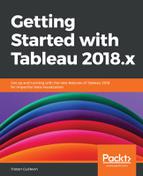Pages act like filters but only show one value at a time. Each value is a Page, and you can click on the Play button to go through all the Pages and create an animation.
A few things to have in mind before we look at any concrete examples:
- You can only use Discrete fields in Pages
- When you put a field in Pages, the Pages card, displayed in the following screenshot, automatically opens:

Here are some things about the Page card:
- The first line displays the selected value, and the arrows allow you to go to the next or previous value.
- The slider shows how many Pages (values) there are, and you move the cursor to go through them.
- On the third line, on the left, you can see the animation buttons. You can use them to automatically go through all the Pages from the first to the last, the other way, or stop the animation. On the same line, on the right, you see the speed buttons. They define how fast Tableau changes the Page.
- At the bottom, you can show the history, or not.
If you decide to Show history, a new menu opens:

In this menu, you can configure how to display the previous Marks (the ones from the preceding Pages). Let's quickly see the different options if you decide to show the history:
- In the first part, you specify which Marks should display the history
- In the second part, you define how many historical Marks to show (all or the last number of your choice)
- The third part allows you to choose between showing the historical Marks as they were, only the trails (the path of the prior point to the next), or both
- Finally, in the two other parts, you can customize the format of the historical Marks or the trails
That's it for the theory, let's build an example together.
